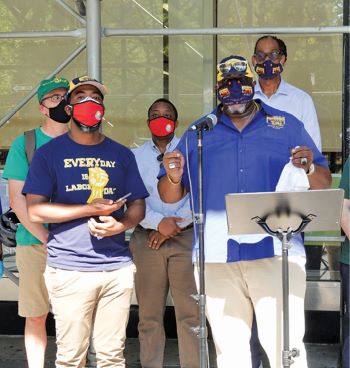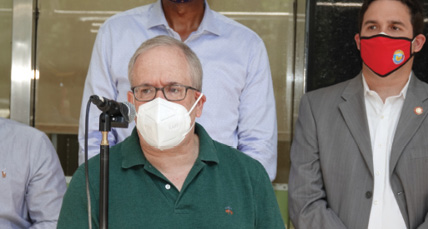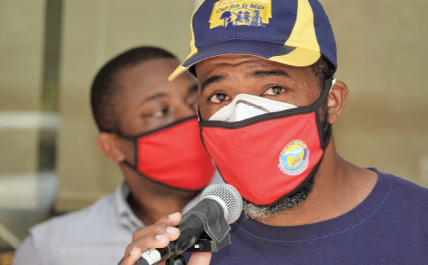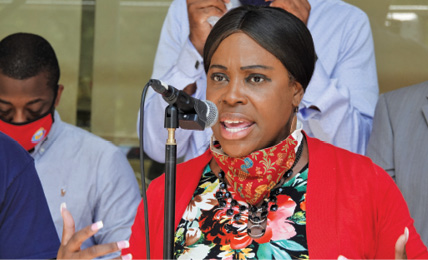Public Employee Press: PEP Talk
Local 372 presses for ventilation and cooling in all public schools



By MIKE LEE
“The excessive heat in school kitchens creates work conditions that are unacceptable, unhealthy, and inhumane. We need safe, healthy, and ventilated school kitchens. We need a permanent fix now!” said Local 372 President Shaun D. Francois I at a press conference Aug. 5 in Manhattan. With union leaders and elected officials, Francois called for Mayor de Blasio and School Chancellor Richard Carranza to impanel a task force to remedy ventilation and cooling systems in all public school kitchens and sent them correspondence asking the same.
Since schools shuttered in March, Mayor de Blasio tasked 3,400 kitchen lunch workers as essential front line help in New York City’s COVID-19 response. These dedicated unionized kitchen staff work in unventilated kitchens at 517 public schools across the five boroughs where temperatures often reach 120 degrees and hotter most days.
Kitchen temperatures in a Manhattan public school exceeded 135 degrees during a recent heat wave as 3,400 essential workers prepared grab-and-go meals to feed hungry New Yorkers during the COVID-19 pandemic.
“You ask how hot? It’s Satan hot!” said Vincenta Hunt, a school lunch worker at IS 59 in Queens. “Every day I come to work. I sweat through my clothes. I break out with heat rash. I also fear what I could bring home to my mom and brother who both have compromised health conditions.”
Hunt and about six other school lunch workers prepare thousands of grab-and-go meals each week to feed hungry people during the coronavirus crisis. She reported the unbearable and unsafe work conditions to her union president after her supervisors couldn’t help.
School Lunch Worker Jarvis Lewis, 73, has fed generations of New York City school kids for more than 20 years at a Brownsville, Brooklyn middle school where windows can’t open more than a few inches, doors remain locked for child safety, and fans blow hot air.
“It’s my job to look out for the kids,” Jarvis said. “Without us feeding and watching over them, where would they be?” Jarvis asked. “But I wonder who looks out for us?”
In July, City Council member Ben Kallos visited the kitchen in Manhattan’s Julia Richmond High School where he recorded 135.9 degree temperatures, he said, violating OSHA safety standards.
“No one should have to work in those conditions,” Kallos said. “The City Council did more to protect horses than our workers.”
Kallos successfully fought to have the Department of Education install a new cooling system in the Richmond High School kitchen.
Local 372 represents 9,000 kitchen lunch workers at 1,700 public schools across the city. Most have very old, very hot kitchens.
Francois said, “As a first step, we are asking the New York City Department of Education and the New York City School Construction Authority to establish a ventilation and rehabilitation task force charged with performing a comprehensive, school-by-school assessment of the ventilation and cooling needs in public school kitchens.”
Local 372 Executive Vice President Donald Nesbit, who worked in public school kitchens for more than 10 years, said that school lunch workers have struggled for decades with non-existent and inadequate cooling and air exchange systems in public school kitchens.
The vast majority of public schools built from the 1930s through the 1990s lack the proper design and electrical systems for acceptable indoor air circulation.
Local 372 leaders said that in many school kitchens and cafeterias, the ventilation systems are outdated and sealed, and some have AC units that are broken.




Tasked with feeding the city’s hungry during the deadliest pandemic in a century, each day Local 372 members are working in cramped kitchens with absurdly high air temperatures. Working in a sweltering, stagnant environment presents serious health hazards that are exacerbated by New York City’s intense summer heat waves.
“It is unacceptable and unsafe for kitchen workers to deal with dehydration, heat stroke, fainting, and other heat-related health emergencies every day. It’s time for essential workers to be treated with human dignity and respect,” Nesbit said.
The COVID-19 pandemic exposed deep flaws and disparities system-wide that forced elected officials to address food insecurity as part of government’s pandemic response.
NYC Comptroller Scott Stringer said, “I am amazed as we look to reopening schools safely for children, teachers, and parents, that front line workers in school kitchens are at risk. It is shocking that Mayor de Blasio failed to have a plan to fix the kitchen ventilation problem in our schools. I pledge to audit and investigate this to make sure you are not left behind.”
Council Member Mark Treyger, chair of the Committee on Education, said, “This is a workers’ safety issue and a public health issue. Last year, we in the City Council convinced the administration to lay out a plan to install air conditioning in all New York City classrooms and it is common sense and the right thing to do to install air cooling systems in all school common spaces, including cafeterias and kitchens, to provide proper ventilation and safe working conditions for those working to feed our children every day.”
More than 1,000 people have signed an online petition to upgrade ventilation and cooling systems in New York City public schools. Additionally, dozens of local lawmakers supported the kitchen workers at the Aug. 5 rally, including Brooklyn Borough President Eric Adams, City Council members Farah Louis, Vanessa Gibson, Health Committee Chair Mark Levine, and Robert Cornegy; State Senator Brian Benjamin, and State Assembly members Rodneyse Bichotte, Michael Blake, Natalia Fernandez, Al Taylor, and David Weprin.
The city and Department of Education have the organizational structure in place to start rehabilitation of public school kitchens. DC 37 Local 1740 New York City School Construction Authority has the architectural and engineering technical professionals who are ready to undertake the work the Task Force deems necessary to fix public school kitchens in all five boroughs.
“The Department of Education and the city can do better by its essential workers and treat them as valued and respected employees,” Francois said. “It’s time for a permanent fix!”
New York City’s COVID-19 feeding program will continue through December.


